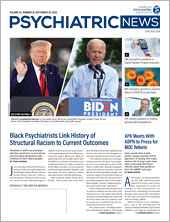Schizophrenia is a debilitating disorder that is associated with significant medical, social, and economic burdens for patients and their families. In particular, numerous studies have found that the average life expectancy of people with schizophrenia is about 20 years shorter than that of the general public.
To help psychiatrists and other mental health professionals provide the best evidence-based care to these patients, APA this month released the APA Practice Guideline for the Treatment of Patients With Schizophrenia.
The practice guideline represents APA’s first schizophrenia guidance since 2009. Since then, numerous new antipsychotics have been approved as have medications to treat tardive dyskinesia, a common side effect of antipsychotics.
There have also been innovations in psychosocial care, including the rise of coordinated specialty care programs for early psychosis intervention, and more emphasis on getting patients involved in the recovery process. As such, the new guideline highlights the importance of a thorough diagnostic evaluation and treatment plan that factors in patient goals and preferences. The practice guideline on schizophrenia is APA’s fourth to use standards set forth by the Institute of Medicine in 2011 to ensure clinical guidelines meet high standards of transparency, manage conflicts of interest, and are scientifically rigorous. It is APA’s first guideline for an entire disorder to use IOM standards.
As with APA’s previous guideline efforts, clinical recommendations were made by an expert work group following a systematic evaluation of relevant literature. All recommendations received two ratings: One assessed how likely is it that the benefits of the intervention outweigh the harms (rated on a scale of 1 to 3); the other assessed the degree of confidence in the supporting data (rated on a scale of A to C).
The expert work group made 24 recommendations, spread across the topics of patient assessment and treatment planning, pharmacotherapy, and psychosocial interventions. Of those, two received the highest rating of 1A: Patients diagnosed with schizophrenia should be treated with an antipsychotic medication; patients with schizophrenia whose symptoms improve while taking an antipsychotic should continue with maintenance antipsychotic treatment. The practice guideline also recommends that patients who have improved on an antipsychotic remain on that same antipsychotic during maintenance therapy, but this recommendation is supported only by moderate evidence (2B rating).
With the exception of clozapine—which the guideline recommends as the first choice for treatment-resistant schizophrenia, patients with high suicide risk, and patients with a high risk of aggressive behavior—the guideline did not make any recommendations about when to use specific antipsychotics.
“Although there may be clinically meaningful distinctions in response and tolerability of different antipsychotic medications in an individual patient, there is no definitive evidence that one antipsychotic will have consistently superior efficacy compared with another, with the possible exception of clozapine,” the work group wrote.
The work group cited a comprehensive analysis conducted by investigators at the Oregon Health and Science University Evidence-Based Practice Center, which served as a principal source of data for the new practice guideline. This analysis suggested that the older second-generation antipsychotics olanzapine and risperidone might be superior for certain symptoms; however, given limited head-to-head comparisons, the work group could not make any strong conclusions (
see story).
Likewise, the guideline does not offer definitive recommendations on the use of long-acting injectable (LAI) antipsychotics relative to oral medications, but noted moderate evidence to support the use of LAIs in patients who prefer this approach or have a history of poor medication adherence.
The guideline includes detailed tables highlighting dosing considerations, metabolic properties, and potential side effects of all approved antipsychotics. The work group wanted to ensure the inclusion of these tables so that physicians and patients could make informed treatment decisions together, said Laura Fochtmann, M.D., a Distinguished Service Professor of Psychiatry at Stony Brook University School of Medicine and vice chair of the guideline work group.
“Since we couldn’t offer specific medication recommendations, we felt it was important for physicians to have that information in one place, since not everyone has access to all relevant drug databases,” she told Psychiatric News.
The tables also emphasize the many differences between approved drugs, Fochtmann continued. “While we can’t say that certain medications are superior or inferior, we want to stress that they are not all the same.”
Given the many medications available for the treatment of schizophrenia, the APA Practice Guideline for the Treatment of Patients With Schizophrenia recommends that antipsychotic selection should be made with input from patients and their support circle as part of a thorough treatment plan that includes appropriate psychosocial therapies. The work group noted that cognitive-behavioral therapy for psychosis, education about schizophrenia, and supported employment programs all have strong evidence (rating 1B) of improving outcomes in patients. The guideline also strongly recommends that patients experiencing their first episode of psychosis should be treated in a coordinated specialty care program. If possible, patients should also receive interventions that improve their self-management skills.
Before any treatment plan can be tailored to the patient, the guideline recommends starting with a comprehensive patient assessment, preferably using elements in APA’s Practice Guidelines for the Psychiatric Evaluation of Adults, published in 2015. Elements of a comprehensive evaluation include assessments of a patient’s physical health, cognitive health, the risk of harming themselves or others, and substance use, including nicotine.
“The importance of the psychiatric evaluation cannot be underestimated because it serves as the initial basis for a therapeutic relationship with the patient and provides information that is crucial to differential diagnosis, shared decision-making about treatment, and educating patients and family members about factors such as illness course and prognosis,” the work group wrote. ■
APA’s practice guidelines are posted
here.

